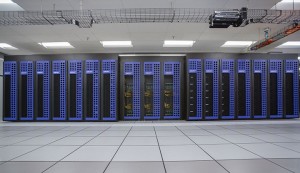
Concerns over data center water usage have become topical both in the High Performance Computing (HPC) industry and even in the general press of late. This is not a bad thing as data center water usage is a legitimate concern. The reality is that the problem is rooted in today’s established approaches to data center cooling. While it sounds like an oxymoron, using hot water liquid cooling for HPC clusters can have a positive impact on data center water usage.
Over the last half-decade, data centers and HPC sites have been focused on data center energy efficiency optimization as measured by PUE (Power Usage Effectiveness) while being wasteful in water usage. This focus has been understandable given the relative OPEX impact on optimizing for energy without consideration for water but the relevance and importance of water resource management generally has moved the “water guilt” issue to top-of-mind for many.
In general, data centers and HPC sites today use cooling towers as the overall heat rejection mechanism by expelling data center heat to the air outside the facility. Data centers impact overall water consumption in two ways: site-based water loss from the process of evaporation at the data center cooling towers and source-based water loss from the use of water by the utility supplying electricity to the data center.
Addressing site-based water management has a number of different approaches. For massive new data center builds (e.g. Facebook) there has been much press but overall limited adoption and, therefore, impact globally on the overall data center footprint of direct air economization designs. These designs bring outside air in, use it to cool IT equipment with, in most cases, water ‘mist’ that is sprayed into the air stream to extract heat.
In contrast, there is the option taken by some to use exclusively direct expansion (DX) coolers, which require no water, rather than traditional cooling-tower based chillers. However, there are issues with this approach. First, these systems can be less efficient than evaporative-based technologies and CAPEX costs can be very high to get sufficient cooling for the data center. Second, because the DX approach requires a larger amount of electricity than the chiller approach for the data center, it is less energy efficient and results in a higher data center PUE (a lower PUE is better) negatively impacting a key metric (PUE) that data center managers have been driving to optimize. Further, depending on the type of energy-generation used by the providing electrical utility, this additional load can mean increased source-based water use at the power plant. As a result, a data center could increase its overall water impact in its attempt to increase its water efficiency.
There is another more flexible approach to the problem that is applicable to both new builds and existing data centers: Direct-to-Chip™ (D2C) hot water liquid cooling as provided by Asetek. This approach uses two sealed liquid loops when implemented across a data center. With D2C, a closed loop hot water liquid cooling circuit brings cooling water directly to the components in each server that generate the most heat and extracts the heat. The heat extracted from the servers is then transferred to facilities water via a CDU at the back of each server rack via heat exchangers. Heat is exchanged between the closed loops for servers and closed loop for facilities water without any mixing of server liquid and facilities liquid.
Due to the superior efficiency of water over air in heat removal and the use of hot water to cool the servers, the facilities side does not need to bring water temperature down to the cold temperatures required by chiller systems. This allows the facilities water loop to use dry coolers for the data center which use no water to expel heat outside the data center. In addition, with RackCDU D2C, there is no need to provide water mist for the dry coolers.
This solution removes 60% to 80% of the heat generated by servers with an all-liquid path. Hot water eliminates the need for chilling the coolant. The air-cooled side of the solution is also more efficient as lower volumes of warmer air are sufficient to cool the remaining components. D2C liquid cooling dramatically reduces chiller use, CRAH fan energy and server fan energy. Additionally, it delivers energy savings of up to 80% and server rack density increases of 2.5x-5x times compared to air-cooled data centers. Hence D2C impacts water usage and, at the same time, improves data center energy use (PUE).
The flexibility of D2C allows it to be used with chillers as well as dry coolers. However, hooking up to the existing chiller system would normally be done only as a transitional approach when a data center has chillers it wishes to continue to use for a time before installing dry coolers. Such is the case when an existing data center is evolving to both a more energy efficient and water efficient approach.
Interestingly, because of its huge impact on water consumption, D2C hot water liquid cooling is particularly appropriate in areas of the world that have scarce water resources. Of note, the western U.S. is facing growing constraints on water usage while, at the same time, facing major growth in their data center footprints. Direct-to-chip liquid cooling enables these data center operators to meet the increasing demands of their user communities while addressing both water and energy operating costs and capital expenditures.
RackCDU’s ability to address the water constraints of the data center is among its many benefits. HPC specialists like Fujitsu, Cray, Penguin and Format have chosen Asetek’s RackCDU technology to provide energy efficiency, higher compute performance, cost savings, and increased density to data centers around the world. As a result, they have provided a tool that adds the benefit of improved “water stewardship” to their HPC and data center customers.
To learn more about water efficiency, and other benefits of Asetek RackCDU D2C, visit us at booth # 1709 at SC15 in Austin, Texas.



























































